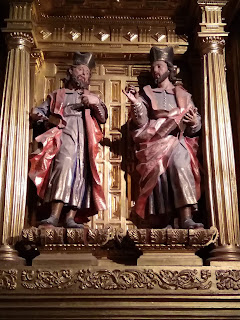Today is the feast of SS Cosmas and Damian, the famous saintly brothers who were medical practitioners in the time of Diocletian (284-306). According to legend, they refused to accept payment for their cures, and they were executed as a part of Diocletian's persecution of Christians. There is a great likelihood that they never existed, but their cult seems to be an old one, and their feast can be found in calendars and liturgical books from all over Latin Christendom. I have several times come across them in Spain, and their widespread distribution in the northern parts of the country would suggest that the cult was introduced to Spain already in Late Antiquity. However, this is merely an hypothesis.
I have written about elements of the cult of Cosmas and Damian in previous blogposts (here and here), but this time I will have a quick look at a spectacular representation from one of the early modern chapels in Segovia Cathedral. The chapel in question is the Chapel of SS Cosmas and Damian, and can be seen in a more complete view here.
Upon the death of Damián Alonso Berrocal in 1603, the archpriest of Pedraza, one of the villages within Segovia's jurisdiction, the cathedral chapter donated this chapel for his inhumation. It appears that the dedication of the chapel to the saintly brothers was occasioned by the archpriest's connection to his namesake saint. In 1629, the retable of the chapel was commissioned, and in the early 1630s the sculptures decorating the retable were completed by a carver.
One of the many interesting elements of this retable is how it conveys the legend of the two saints. As is typical of medieval and early modern Christian art, stories become compressed into a sequence of highlights, capturing the most important points of the legend of the saints, reminding the viewers about the story, and demonstrating to the saints in Heaven that their ministrants on earth were familiar with their story and therefore worthy of their help and prayers. In this, the retable in Segovia Cathedral is typical and in no way unique, but nonetheless fascinating and astounding in the way it communicates the story of the brothers.
At the base of the retable we can follow the story. The two brothers heal a man bitten by a serpent, a miracle that is likely to be an echo of one of the stories about Saint Paul, who reportedly was bitten by a snake during one of his missions and was unharmed. The second and final scene of the base is their execution before the seated emperor. It is noteworthy that their death by decapitation - a very common way of dying for late-antique saints - follows after a failed attempt at killing them by arrows, as the arrows redounded back onto their would-be executioners.
There are several elements of the legend of Cosmas and Damian that have not been included in the version of the retable. The story of how their sanctity was confirmed by a speaking camel, and the miraculous cure of how they performed a leg transplant are not to be found, for instance. The absence of these episodes, however, are only natural given the limited space for visual storytelling in the retable, and by looking at what is kept and what is omitted, we can understand what was considered to be the most important elements of the story.


Ingen kommentarer:
Legg inn en kommentar